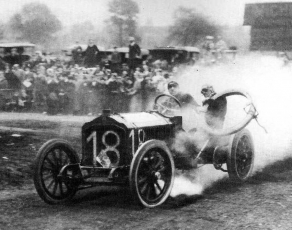
1906 Vanderbilt Cup Race
The greatest Vanderbilt Cup Race hampered by spectator fatality
Location: Nassau County, Long Island, New York
Date: October 6, 1906
No greater evidence of the success of the Vanderbilt Cup Race emerged than when popular culture embraced it. In January 1906, the two races inspired a Broadway musical titled, aptly enough, “The Vanderbilt Cup,” starring 17-year old sensation Elsie Janis. Before the 1906 competition, race participants had box seats to watch Janis perform on stage: George Robertson, Ralph Mongini, Al Poole, Walter Christie, Louis Wagner, unidentified, Louis Vivet and Joe Tracy. The show featured appearances by track racer Barney Oldfield who developed special effects to simulate the race on stage using a treadmill.
Prior to the 1906 American Elimination Trial to select five American entrants, veteran Vanderbilt Cup Race driver Joe Tracy (right) and his riding mechanician Al Poole gave their new 90-hp Locomobile a practice run around their Lakeville Hotel headquarters near Lake Success. Tracy won the American Elimination Trial after battling for much of the distance with Hubert LeBlon’s Thomas entry. Tracy averaged 52.3 mph for the 297 mile race.
Another innovative machine showcased in the 1906 American Elimination Trial was the unique, air-cooled Frayer-Miller entry with designer Lee Frayer at the wheel. Frayer’s riding mechanician, 16-year-old Eddie Rickenbacker , was arguably the most significant historical figure present that day. His greatest moments came from his career in aviation, where he became America’s World War I flying ace and, later in life, rose to President and General Manager of Eastern Airlines.
For the third time in as many years, drivers in the 1906 Vanderbilt Cup Race faced a new course layout. The construction of a new trolley line stretching from Queens to Mineola forced a redesign of the western section of the course from its 1905 configuration. The grandstand returned to its 1904 site on Jericho Turnpike in Westbury. The first 12 miles of the new 29.7-mile course was unaltered from 1905, including the turns at Jericho, East Norwich, and Bull’s Head Hotel in Greenvale. The remaining 17.7 miles presented hilly sections and more challenging turns than drivers had seen before. After heading south on Glen Cove Road, the revised course included a “Hairpin Turn” in Old Westbury, two new turns in Roslyn, the challenging hills in Manhasset Valley, and two more turns in Lakeville. The final challenges were a turn at Krug’s Hotel in Mineola and a nearby railroad crossing heading back east on Jericho Turnpike. In all, the course presented 11 turns per lap or a total of 110 during the 10-lap, 297-mile race.
Louis Wagner (left) and riding mechanician Louis Vivet prepared to begin the race in the French 100-hp #10 Darracq. The Motor Way called the car “the peculiar wire wheeled, little Darracq.” Behind Wagner was the gray Italian #12 Itala driven by Alessandro Cagno. Foxhall Keene’s #11 Mercedes was absent as it had failed to start due to cracked cylinders discovered shortly before practice began.
Trade magazine Motor World called the Jericho Turnpike section of the course as “ that living, craning, waving lane from Mineola to the stand.” As the race began, spectators broke though six foot protective fences at Krug’s Hotel in Mineola to venture on to the road.
With a cry of, “Hundreds are going to be killed if the crowd is not controlled,” Locomobile driver Joe Tracy pulled to a stop to warn race officials after completing his first lap. Referee Vanderbilt jumped into his Mercedes with race chief surgeon Louis Lanehart and made one fast lap to check out crowd conditions and to clear the course. The crowd temporarily returned to positions behind the fences surrounding Krug’s Hotel.
The blue unique 50-hp front-wheel drive #17 Christie, driven by its designer Walter Christie, sped around the Hairpin Turn. Most of the Old Westbury spectators probably did not appreciate the danger, but more than 2,000 people risked their lives crowding the course on the turn.
One of the stirring moments that built the legend of the Vanderbilt Cup Race thrilled the crowd at the “Hairpin Turn.” A spare tire and rim strapped to the back of the #18 Lorraine-Dietrich broke loose and began to thrash the gas tank. Riding mechanician Franville clutched the heavy mounted tire and lost his balance. Just as the car skidded through the turn, the French driver Arthur Duray handled the tight corner with one hand on the wheel while rescuing his assistant with his left arm.
Vincenzo Lancia’s 120-hp #4 F.I.A.T. maintained his speed up Manhasset Hill on the North Hempstead Turnpike, one of the more challenging portions of the course. The hill presented a steep upgrade for about one and a half miles. Based on his spirited performance in 1905, Lancia was a crowd favorite and received a resounding round of applause from the grandstand crowd at the start and at the Spinney Hill grandstand.
Approximately ¼ mile past Krug’s Hotel, Felice Nazzaro in his #8 F.I.A.T. sped past the only railroad grade crossing on the course on Jericho Turnpike in Mineola. At the crossing, the Long Island Railroad placed a stopped train for their guests to view the race.
Elliot F. Shepard Jr., a 30-year-old American and William K. Vanderbilt Jr.’s cousin, drove the most powerful car in the race, a French 130-hp French Hotchkiss. Shepard did not realize that he would soon become the center of controversy for the 1906 race.
Just one of the many spectators persistently crowding the course, Curt Gruner, a 33-year-old mill foreman from Passaic, New Jersey, pressed his luck too far in 1906. Slightly to the east of the Long Island Railroad crossing on Jericho Turnpike near Krug’s Hotel, Gruner found himself in the wrong place at the wrong time. Elliot Shepard Jr.’s Hotchkiss struck him down on the lap six, killing the unfortunate man.
As Wagner was about to win the contest, starter Fred Wagner waved what is believed to be the first checkered flag used to signify the finish of an auto race. Standing on the railing above the flag, Willie K saluted the victor. The winning Darracq averaged 62.7 mph over the 297.1-mile race. Lancia’s F.I.AT. finished second, only three minutes and 18 seconds behind, followed 16 seconds later by Arthur Duray’s Lorraine-Dietrich.
The victory of driver Louis Wagner (left) and his riding mechanician Louis Vivet was the third consecutive win for France. Wagner called the race “certainly the most nerve-wrenching contest in motoring history,” and later wrote a magazine article about the horror of racing through roads crowded with people.
While the press praised the entertainment value of the race, the death to a spectator also fueled editorials crying for crowd control reform. The bone of contention was the continued use of public roads. Two days after the race, AAA President John Farson appointed a special committee to look into developing a privately owned speedway. At an October 18, 1906, meeting William K. Vanderbilt Jr. was named president of a newly formed “Automobile Highway Association.” The company would later become Long Island Motor Parkway, Inc., responsible for developing the first road built specifically for the automobile.
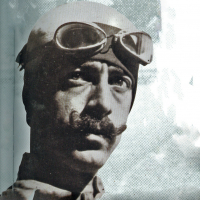

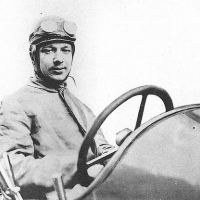

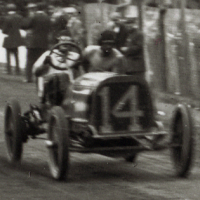
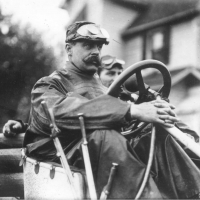
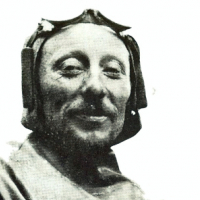
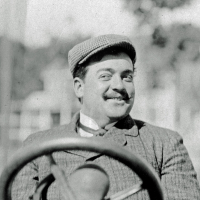
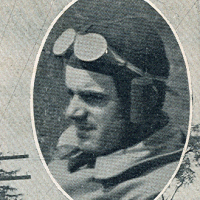
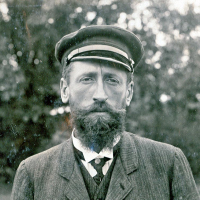
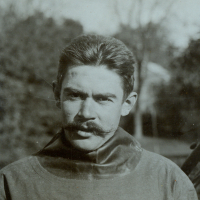
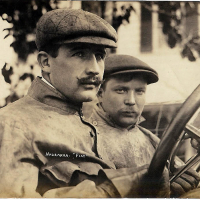
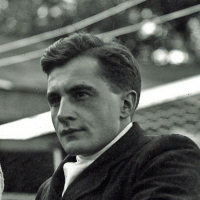
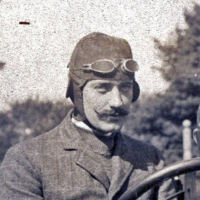
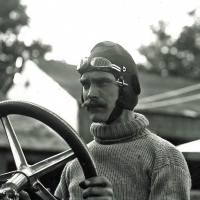
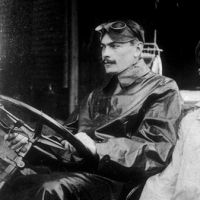
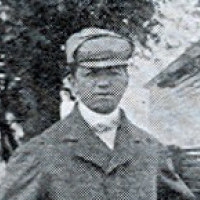
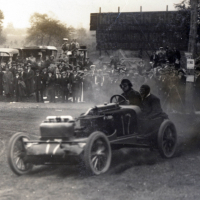
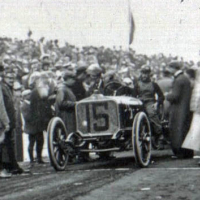
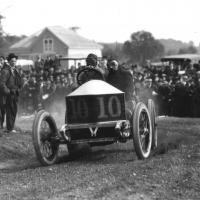
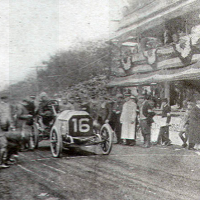
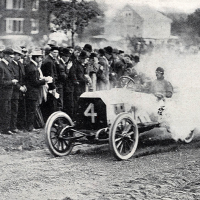
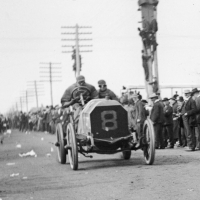
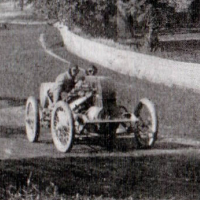
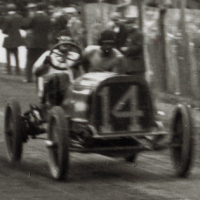
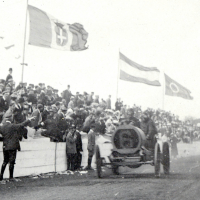
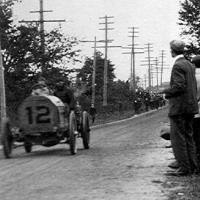
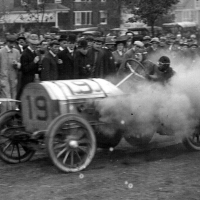
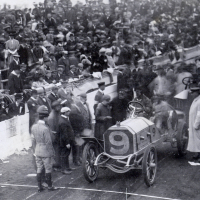
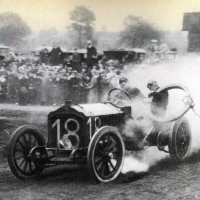
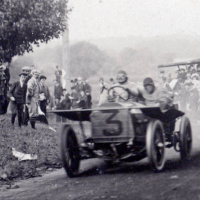
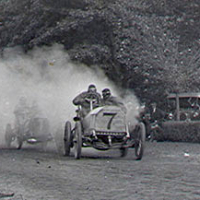
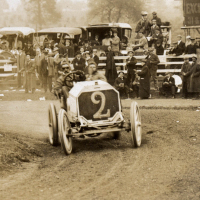
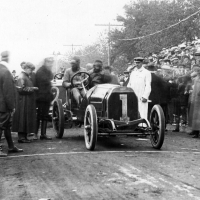

The partially completed train crossing is obviously Mineola or Albertson. Staring at the picture it could easily be…